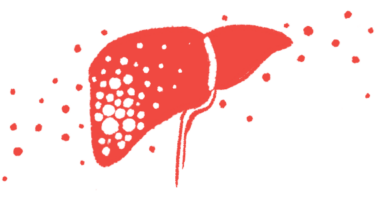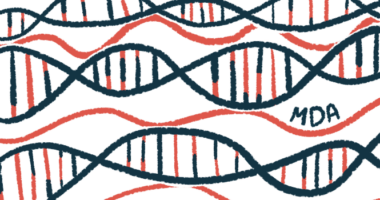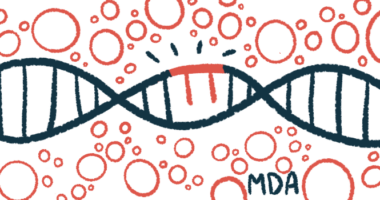Zolgensma Helps Pre-symptomatic Babies Attain Motor Milestones

Zolgensma safely and effectively halts disease progression in infants genetically diagnosed with spinal muscular atrophy (SMA) but not yet showing symptoms, according to final data from the SPR1NT Phase 3 clinical trial.
“When treated with Zolgensma prior to the onset of symptoms, not only did all 29 patients enrolled in SPR1NT survive, but were thriving — breathing and eating on their own, with most even sitting, standing and walking without assistance,” Shephard Mpofu, MD, senior vice president and chief medical officer of Novartis Gene Therapies, which markets the therapy, said in a company press release.
The findings — concerning infants likely to develop SMA type 1 or type 2 and who were followed for up to two years after the therapy’s single dose — further support “the significant and clinically meaningful benefit of Zolgensma in presymptomatic babies with SMA,” Mpofu said.
The results were detailed in two separate studies, published in Nature Medicine.
One of the studies was titled “Onasemnogene abeparvovec for presymptomatic infants with two copies of SMN2 at risk for spinal muscular atrophy type 1: the Phase III SPR1NT trial,” and the other, “Onasemnogene abeparvovec for presymptomatic infants with three copies of SMN2 at risk for spinal muscular atrophy: the Phase III SPR1NT trial.”
Administered directly into the bloodstream, Zolgensma (onasemnogene abeparvovec-xioi) uses a modified and harmless virus to deliver cells a working copy of SMN1, the mutated gene in SMA.
In the U.S., the one-time gene therapy is approved for newborns and toddlers up to age 2 with a genetic diagnosis of SMA. In the European Union, it’s available to children weighing up to 21 kg (about 46 pounds) with a clinical diagnosis of SMA type 1, or to those still without symptoms but carrying up to three copies of the “backup” SMN2 gene.
A higher number of SMN2 copies is associated with a milder disease. Patients with two gene copies are likely to develop type 1 disease, a severe form that typically results in swallowing difficulties, being unable to meet early motor milestones, and needing permanent ventilatory support, or death by the age of 2.
Those with three copies are expected to have SMA type 2, a milder form marked by being unable to walk without support, and often linked to swallowing and breathing problems.
The two-year SPRINT Phase 3 trial (NCT03505099) tested Zolgensma in 29 pre-symptomatic babies (up to 6 weeks old) with SMA who carried two (14 patients) or three (15 patients) copies of the SMN2 gene.
Infants likely to develop SMA type 1 (type 1 group) were given Zolgensma at a median age of 21 days and followed for 1.5 years. Those in the type 2 group received the therapy at a median of 32 days and were followed for two years.
Data from these patients were compared with findings from matched, untreated infants with SMA and two or three SMN2 copies who participated in a natural history study.
Results showed that all the toddlers in both groups were alive and free from ventilator or feeding tube support at last assessment, emphasizing the therapy’s survival benefits and in maintaining breathing and swallowing functions in infants with these two SMA types.
As previously reported at the 2021 European Academy for Neurology Virtual Congress, all of those at risk of SMA type 1 met the main goal of sitting without support for at least 30 seconds at some point in the study.
This milestone was achieved within the World Health Organization (WHO) window of normal development in 79% of them. All of the 12 toddlers assessed for that milestone at the end of the study retained that ability at age 1.5.
Most patients in the type 1 group were also able to stand (79%) and walk (64%) independently, and many attained these milestones within the normal age range.
“In contrast with the natural history of SMA type 1, motor improvements in SPR1NT were evident within 3 months of treatment, when many children had [motor] scores similar to those of healthy peers,” the researchers wrote.
Amy and Adan Medina said their daughter, Amelia, had met all of her motor milestones on time and was sitting, standing and walking on her own. Amelia was the first infant treated in SPR1NT and was likely to develop type 1 disease.
“She is indistinguishable from her healthy peers without SMA,” Amy Medina said. “This is especially meaningful to our family as our older two children with SMA were born before treatment with a one-time gene therapy was even a possibility.”
Data from the type 2 group — also shared at the 2022 Muscular Dystrophy Association Conference — showed the primary goal of standing alone for at least three seconds was achieved by all 15 toddlers and within the WHO window of normal development in all but one (93%).
“All children maintained this motor milestone at the 24-month study visit,” the researchers wrote.
All but one of the toddlers also went on to walk independently, with 11 (73%) of them attaining this milestone at an age typical for children without SMA.
Zolgensma’s safety profile was consistent with that reported in previous studies, with no new safety concerns identified.
The findings were in sharp contrast with the natural history of SMA types 1 and 2, highlighting that treating infants with Zolgensma “before the appearance of SMA symptoms essentially allows them to grow and develop as normal children,” the researchers wrote.
“This emphasizes the urgency of timely diagnosis and treatment afforded by newborn screening” of SMA, the research team added.
“In the longer term, newborn screening coupled with presymptomatic treatment holds promise to improve health-related quality of life and reduce overall medical costs” of these infants, the researchers wrote.
All eligible children were invited to enroll in a study called LT-002 (NCT04042025), wherein they’ll be followed for up to 15 years to assess the therapy’s long-term safety and effectiveness. Novartis expects to publish updated motor function data from the study later this year.
So far, more than 2,000 SMA patients have been treated with Zolgensma across clinical trials, managed access programs, and in the commercial setting, according to Novartis Gene Therapies.









